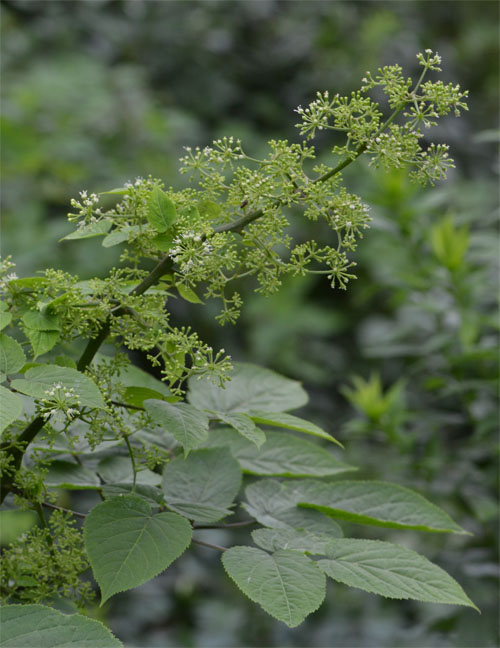I have had two Aralia racemosa (american spikenard) in an area that benefits from a bit more sunlight than does the rest of my tree covered woodland garden. Too much sun, I feared at first. The young plants did not do a whole lot of growing, that is until this year. While I thought I lost one of the plants to rabbits last spring, both emerged this year, and they grew with a vengeance, seemingly to make up for the unsuccessful attempts in years prior. They are now both over 5 foot tall and almost as wide. They began displaying little greenish white flowers in late June. Now, in late August dark red berries are everywhere. The plants are framed by joe pye weed on one side and pokeweed on the other. They provide a height crescendo on an island of beebalm, milkweed and butterflyweed.

American spikenard grows in a wide range of soils and although it prefers moisture it will tolerate dry conditions. The plants will hopefully multiply by self-seeding as well as by their spreading rhizomes. American Spikenard may look like a shrub but its structure dies down in the winter leaving no evidence. In the spring it emerges quickly to display its dark stems and the foliage turns a nice dark green as the season progresses.
Aralia racemosa has several herbal uses – the plant is related to Ginseng and the roots are used in tea, soup, and root beer. Native Americans used the root medicinally, for external use on burns, ulcers, skin irritations, and swelling. The berries can be made into wine, jam, or vinegar.
Do you have any more info on making jam from the berries? I have a nice plant here in western Mass. with many berries and they have a nice taste, but most sources say they are inedible. I’m looking for someone has actually eaten this stuff without ill effects.
Hi Allen – the jam recipe is not any different from other fruit based jams – spikenard berries, sugar, lemon juice (although that was likely not part of the original recipes). The fruits are edible but it is all about the timing – the skin of the fruits when ripe breaks easily and the fruits are small on little stems. It is somewhat labor intensive to separate the fruits from the stems, and one plant may not produce enough to make it worth your while. The berry flavor is sweet and citrusy, almost like biting into an orange, so you may want to mix it with other fruits that would benefit from a citrusy overtone.
The extreme drought conditions shriveled the main plant and its berries in my yard, but there are seedlings from last year and tuber offshoots that seem fine – so the plant(s) will come back